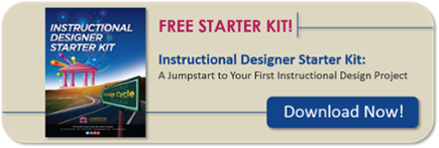
Photo by: Annie Spratt via Unsplash
Instructional Designers are constantly faced with the challenge of putting together solid performance-based training that sets learners up for success on the job. Their real-world circumstances are often less than ideal as they are consistently asked to work their magic with tight and unrealistic constraints. As training professionals, we know there is no magic wand, but we do have choices. One of those choices is blended learning. It offers the instructional designer a variety of strategies to choose from to help solve the complexities of the work environment’s training needs. There is no perfect blend of strategies, but there is a 3-step process we explore in our Blended Learning workshop that helps simplify the decision-making process.
Step 1: Identify Constraints
Before you choose a core strategy, like traditional instructor-led training or e-learning, you must first identify the instructional design constraints you are facing (e.g. time, budget, organizational mandates/policies, technical, design, etc.). This is a critical first step.
Step 2: Select Strategy
Once you have identified your constraints, it is time to consider the best core strategy (or strategies) that is most feasible for the type of content you are designing for. Will it be a traditional strategy, an e-learning strategy, or a combination? Not only do you need to assess the type of content, you will also need to consider other key factors such as the location of the learners, available resources, and deadlines, along with their implications.
Step 3: Consider Performance Support Activities
Unfortunately, we don’t live in an ideal world. Due to tight constraints, the instructional designer may need to incorporate Performance Support Activities (PSA’s) to support the core training strategy solution. While there’s a wide variety of PSA’s, some of the most common are coaching sessions, assigned reading, and group discussions and assessments.
Remember, there is no perfect blend. If you would like to explore best practices and dig a little deeper into the available strategies and options, I encourage you to register for our Blended Learning workshop. You may discover the ideal blend for you!
Note: This post is part of a workshop intersession activity. As such, it is monitored in a slightly different manner than the other blog posts on our website. If you are not a participant in the applicable workshop, but have a question you would like answered, please feel free to contact us.


64 Responses to “A 3-Step Decision-Making Process for Blended Learning”
I believe that all training should be some type of blend. With the variety of ways that adult learners (or all learners) learn, I believe it would be best to have resources that ensure understanding by all students (regardless of learning style) and allow different ways to gather and demonstrate their understanding.
I love the structured approach to determining if blended approach work. Step 3 is the one I am especially interested in because having done blended learning, I have found we focus on the elearning and the virtual classroom piece and dont put enough thought into what else needs to be done to ensure performance is addressed by looking at various performance support activities’
I am looking forward to applying Blended Learning principles in my training programs.
Prioritizing the tasks gives you a great overview what what is important and needs to be in the core strategy and what could be a PSA.
Currently enrolled in the Blended Learning program.
Some great insights so far into adapting existing material into a model that fits our new “normal.”
Looking forward to the second day!!
I’m currently enrolled in the Blended Learning workshop. I’m truly excited to take some of the blended learning suggestions back to my organization.
I like how the process of blended learning allows a trainer to adapt with constraints as well as adapt their curriculum to best suit their learners.
Some people might consider the most meaningful learning to happen during the “Performance Support Activities”, especially a great coaching relationship. I wonder if the term “support” activities rather than “core” might devalue things like coaching or group discussions outside of what is considered “core”?
I love the concept of blended learning and look forward to prioritizing the tasks in the curriculum I use.
I like the idea of the PSAs. It satisfies the learning style for adult learners who like to go at their own pace (maybe quicker than a traditional VILT or OLT) and offers a wide variety of media options to diversify the learning methods rather than what’s limited in an ILT or VILT for sake of time and content sharing options.
I think blended learning allows trainers to train with a variety of approaches to achieve optimal results.